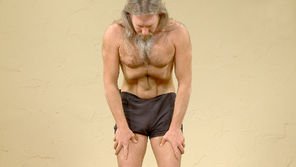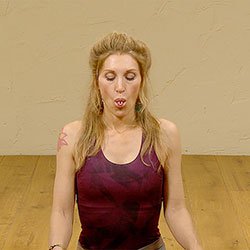Pranayama uses the breath to direct and expand the flow of prana in our energy channels – the Nadis. Learn about the different types of breathing techniques and the benefits of including pranayama in your yoga practice.
What is pranayama?
Swami Satyananda Saraswati describes the techniques as providing:
“…the method whereby the life force [prana] can be activated or regulated in order to go beyond one’s normal boundaries or limitations and attain a higher state of vibratory energy and awareness.”
In The Heart of Yoga, Desikachar explains that when we are unwell, feeling stuck, depressed or lacking in drive we have too little prana within the body – we have more of it outside our body instead. The reason for this is because the prana in the body is forced out by something else, something that does not belong there which he calls “rubbish”. When we practise pranayama we are clearing this “rubbish” from our body and so allowing more and more prana to be within the body instead of outside it.
“When we practise pranayama the veil is gradually drawn away from the mind and there is growing clarity. The mind becomes ready for deep meditation” (yoga sutra 2.52)
So by practising pranayama we are clearing the obstacles in our bodies, allowing breath and energy (prana) to flow freely. Our breathing is improved, our bodies function better and we clear and calm the mind.
Pranayama techniques focus on one or more of the four parts of the breath:
- Inhalation (puraka)
- Internal retention (antara-khumbaka)
- Exhalation (rechaka)
- External retention (bahya-khumbaka)
The exhalation is said to be the most important part of the breath – only when we can exhale and empty fully can we take a full new inhalation.
The benefits of different pranayama techniques
Ujjayi Breathing
Ujjayi Breathing is usually practised in Ashtanga Yoga classes. Also known as Ocean Breath or Victorious Breath. Ujjayi creates heat in the body and it also creates stability. Using Ujjayi breath during asana practice can be a reminder and an indicator not to rush through poses and not to sacrifice the breath for the sake of getting into an idealised shape of the pose.
Returning to Ujjayi in Tadasana after a strenuous pose or sequence, or in times of stress, can help lower our heart rate back down again. Sitting, spending time with deep Ujjayi breathing increases the awareness of our breath. We can use this time to learn how to breathe fully using our full lung capacity, instead of shallow breathing as most of us have a tendency to do.
Nadi Shodhana
nadi = subtle energy channel; shodhan = cleaning, purification; pranayama = breathing technique
Alternate nostril breathing (Nadi Shodhana) is one of the most important breathing techniques. It balances two of the most significant nadis or energy channels, Ida and Pingala, which criss-cross the central nadi, Sushumna and each of the chakras running up the spine.
Nadi Shodhana helps balance the breath through both nostrils – we usually have one which is more blocked and this will change through the day. Nadi Shodhana also balances the two hemispheres of the brain. It is an excellent relaxation technique, calming the mind and generally bringing balance to the whole system. It improves concentration and mental focus as it clears out blocked energy channels in the body.
Kapalabhati
Kapalabhati is also known as Skull Shining breath, Kapala means skull and Bhati means light. The emphasis is on the exhalation through strong, fast abdominal contractions. For this reason it has a cleansing effect on the breathing pathways. The inhale follows naturally after the strong exhale. It improves circulation, especially to the brain, energizing the mind and waking up your system.
Kapalabhati also creates heat and increases and stimulates the digestive fire (agni) by strengthening and ‘massaging’ the abdominal muscles and digestive organs. This agni helps to burn the “rubbish” Desikachar talks about.
Agni Sara / Fire Breath
In Agni Sara or Fire Breath, the focus is on expelling the outbreath in the same way as Kapalbhati. It has many of the same benefits for the abdominal organs and muscles. It is often taught using one nostril at a time and at a slower pace. This makes it more accessible to people starting out with Pranayama.
Pranayama techniques are sometimes taught differently depending on the teacher and style of yoga. For example, in the Kundalini Yoga tradition, Agni Sara is taught in the same way as Kapalabhati. It is also sometimes taught by expelling the breath fully, applying Jalandhara Bandha (throat lock), then contracting and expanding the abdomen quickly while still comfortably retaining the exhalation. This variation also raises energy levels, stimulates the appetite and improves digestion.
Bhastrika
Bhastrika is also known as Bellows Breath. It differs from Kapalabhati and Agni Sara in that the focus is on the inhalation just as much as the exhalation. The abdominal muscles are used to strongly contract (exhale) and expand (inhale) – ‘bellowing’ the breath in and out.
Like the previous two pranayama techniques, it produces heat and energises the body. Bhastrika is said to balance the doshas and their associated humours – phlegm from Kapha, bile from Pitta and wind from Vata. It balances the nervous system, calming the mind ready for meditation.
Nauli Kriya

Nauli Kriya is a strong pranayana technique and is known also as one of the Shatkarmas (Shat = Six; Karma = Action) or purifications as is Kapalabhati. Nauli is a technique of abdominal massage or churning.
From a standing position, with hands on thighs, the breath is expelled as much as possible through the mouth. Then, during the retention of the exhalation, the bandhas are applied and the muscles of the abdomen are contracted. First the rectus abdominii (RA) muscles – forming an arch down the centre of the lower torso. Then the left RA muscles are isolated and then the right, eventually making a churning motion. Watch Andrew explain Nauli Kriya.
Nauli is an advanced practice which massages and tones the entire abdominal area – the muscles and nerves, and the organs of the digestive, excretory and reproductive systems. It stimulates Manipura chakra – the storehouse of prana and associated with personal power.
Samavritti
Samavritti means equal ratio and is sometimes called Square Breath. Here, the focus is on all four parts of the breath equally and its aim is to balance them so that they are the same length. This is incredibly calming for the body and teaches us awareness of breath and prana flow. Samavritti focuses the mind helping to remove distractions as so making it easier to concentrate and move on to meditate. Samavritti is also great because you can practise it anywhere without people noticing!
Bhramari
Bhramari or Bee Breath, uses sound and breath to calm the mind and nervous system. It directs the mind inwards as the eyes and ears are closed. Bhramari is beneficial if you are feeling anxious or unsettled and helps concentration and memory. It relieves tension in the brain so can help with headaches and reduces anger or irritability.
This is helpful to practise if you are studying or doing some other kind of intense brainwork….as long as you are not in a public library!
Sitali and Sitkari

Sitali and Sitkari are two related pranayama techniques where the breath is inhaled through the mouth rather than the nose. In Sitali the sides of the tongue are curled up and the breath is inhaled slowly through this straw-like shape.
Not everyone can make this shape with their tongue; however they can practise Sitkari which has the same benefits.
In Sitkari (Hissing Teeth Breath) the breath is inhaled through closed the teeth (lips open). Both these techniques are cooling for the body so are good to do in the summer or if you have a lot of Pitta. They are also cooling for your temperament – and said to reduce hunger and thirst.
By including pranayama as part of your yoga practice you will see benefits on a physical, psychological and energetic level.
You can practice these techniques online with EkhartYoga in our Ten days of Pranayama program.

